An Insider’s Guide to Writing High Converting Long-Form Sales Copy
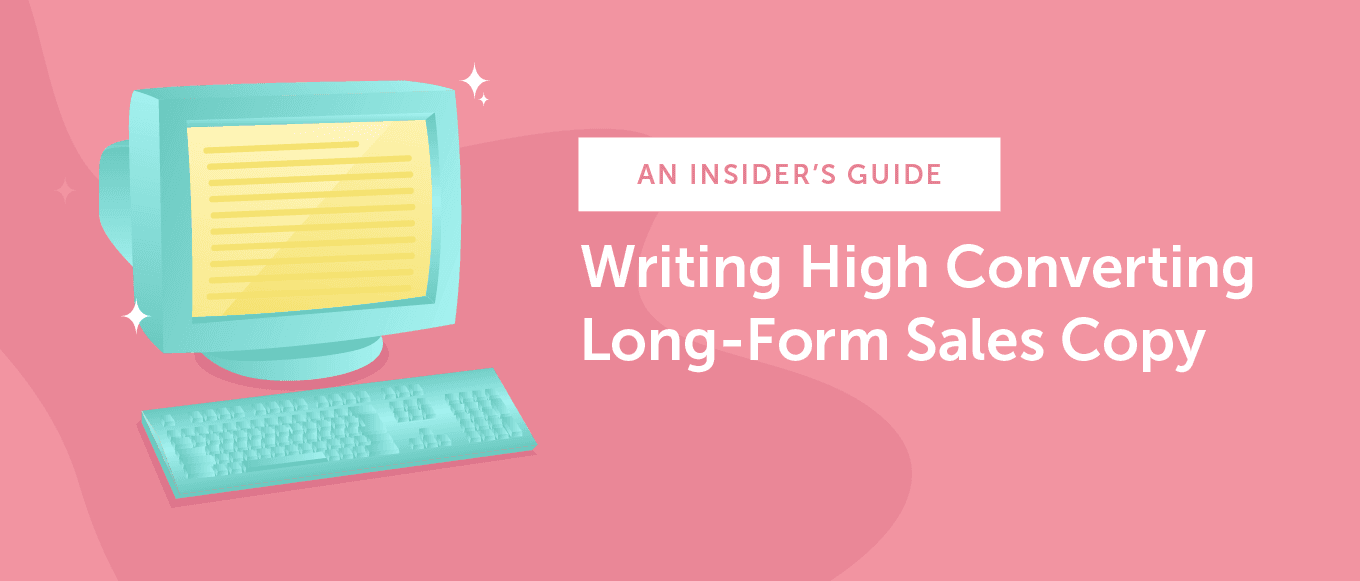 You probably don't like a long-form sales page. You're not alone.
Nobody wants to scroll endlessly down a sales page to be told in a dozen different ways why they should buy a product. As a business owner, this isn't important. What matters is sales.
David Ogilvy wrote that he had only seen short copy beat long-form sales copy twice in his career. It is quite a statement coming from the founder of one of the largest marketing agencies in the world.
Of course, you don't need to take his word for it.
JV Zoo is an affiliate marketing platform. Many marketers use the platform to run software promotions. The top promos can generate $1,000,000+ in a fortnight (I was involved in a $600,000+ product launch).
It is a niche where the conversion rate matters.
Marketers pay copywriters thousands of dollars to create sales copy for an offer. The most successful promotions on the platform all use a long-form sales page. And these offers convert.
You probably don't like a long-form sales page. You're not alone.
Nobody wants to scroll endlessly down a sales page to be told in a dozen different ways why they should buy a product. As a business owner, this isn't important. What matters is sales.
David Ogilvy wrote that he had only seen short copy beat long-form sales copy twice in his career. It is quite a statement coming from the founder of one of the largest marketing agencies in the world.
Of course, you don't need to take his word for it.
JV Zoo is an affiliate marketing platform. Many marketers use the platform to run software promotions. The top promos can generate $1,000,000+ in a fortnight (I was involved in a $600,000+ product launch).
It is a niche where the conversion rate matters.
Marketers pay copywriters thousands of dollars to create sales copy for an offer. The most successful promotions on the platform all use a long-form sales page. And these offers convert.
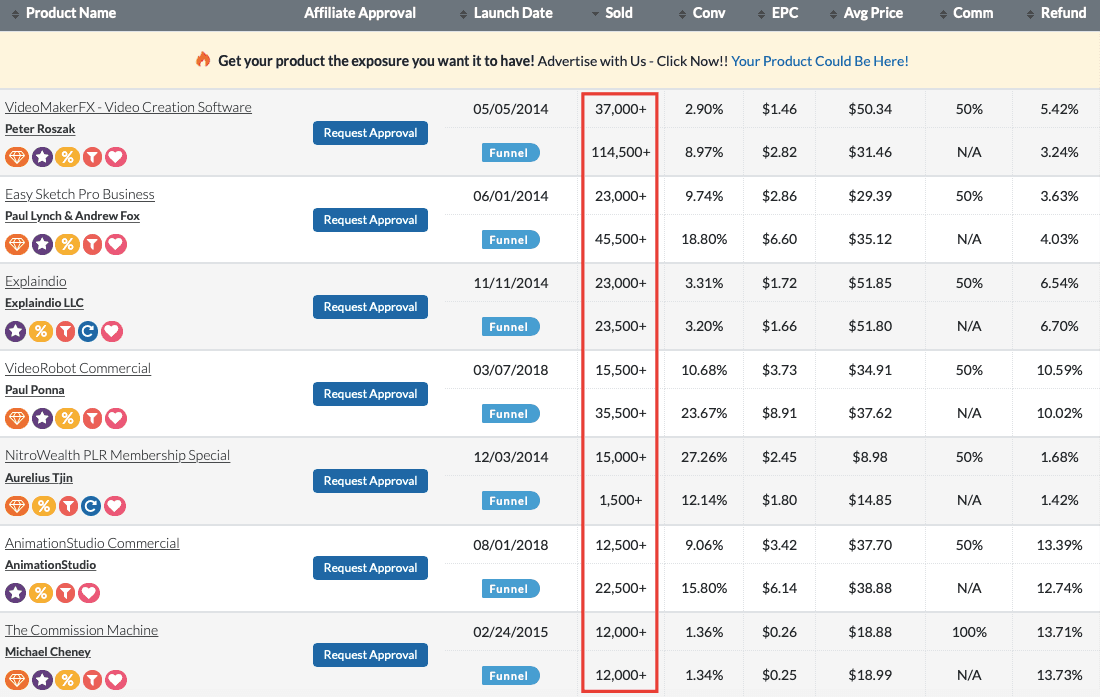 In this guide to writing long-form sales copy, I’ll share actionable tips on how to create your own sales page. I’ll even give you a framework you can steal for writing sales pages.
In this guide to writing long-form sales copy, I’ll share actionable tips on how to create your own sales page. I’ll even give you a framework you can steal for writing sales pages.
An Insider's Guide to Writing a High Converting Long-Form Sales Copy by @nhdprins via @CoSchedule
Click To TweetDOWNLOAD: Long-Form Sales Page Checklist
Make sure you're applying the classic AIDA (Attention, Interest, Desire, Attention) copywriting formula correctly on every sales page you write with this 15-point checklist.What is a Long-Form Sales Page
The name is a bit of a giveaway… A long-form sales page contains a lot of sales copy. There are two types of long-form sales page. The first style, which dates back to before the internet, is the long-form sales letter or editorial piece. These were designed to be placed in newspapers and magazines, or sent via direct mail. The example below is one of the most famous cases of a long-form sales page. It was written almost a century ago by John Caples.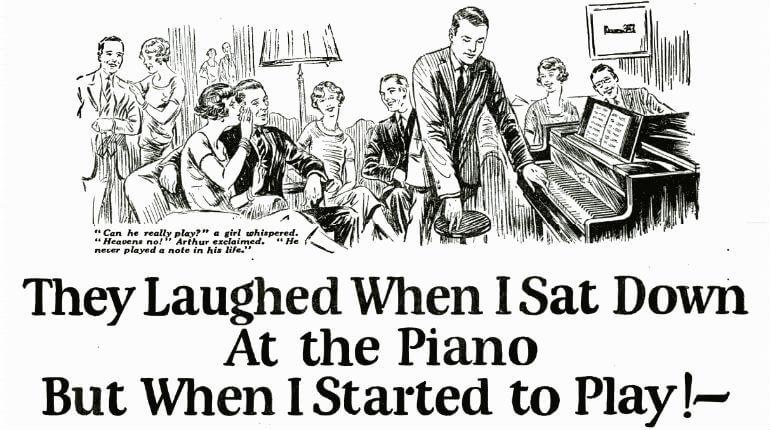 Then you have long-form sales pages designed for the digital age. They look a lot more like a sales page, with prominent buy buttons.
And these pages can be long, like abnormally long.
Then you have long-form sales pages designed for the digital age. They look a lot more like a sales page, with prominent buy buttons.
And these pages can be long, like abnormally long.
 This sales page was so long I couldn’t even do a web page print in one shot.
You probably don’t come across long-form sales pages like this very often. There’s a good reason for this. Long-form sales pages are designed for the hard sell. They are used online for:
This sales page was so long I couldn’t even do a web page print in one shot.
You probably don’t come across long-form sales pages like this very often. There’s a good reason for this. Long-form sales pages are designed for the hard sell. They are used online for:
- Pay Per Click landing pages
- Sales pages for your email list
- Sales pages for webinar attendees
Long Form Sales Page Versus Short Sales Page
There are several characteristics most long-form sales pages share. These characteristics include:- Clear offer: They sell one product
- No navigation: The only place a reader should go is up or down the page. The best place they can end up is your checkout
- Have a narrative structure: There is a logic to how the narrative pulls readers into and down the sales page
- Large Centered Crosshead: Clear sub-headlines that highlight main points the copywriter wishes to
- Hard to Miss Purchase Info: This will include deadlines, guarantees, payment options, etc.
- Bullet Points: Clear overview of the product features, benefits, and outcomes
- A global navigation menu and links to other content
- An awareness of the fold and why you should care about it
- An easy to scan aesthetically pleasing design - often following F-pattern reading
- Less prominent pricing and cost associated copy
- Multiple CTA in one place - for example - Buy Now, Learn More, etc.
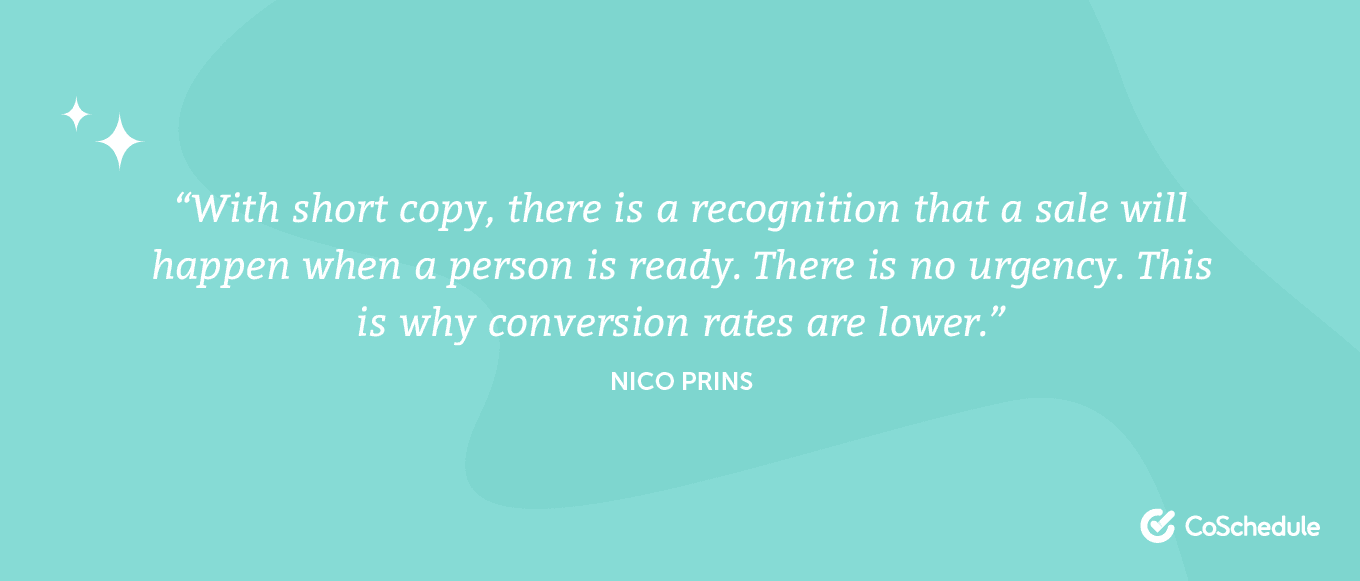
When Should You Use a Long-Form Sales Page
You might be thinking that I’m suggesting a long-form sales page is a miracle cure for your problems. I’m not. There are particular niches and circumstances where long-form sales copy performs well. Products and situations that a long-form sales page are suited to include:- Information products like online courses, PDFs, etc.
- Heavily discounted product or a limited time offer
- When the product costs more than $20
- Any product that is available for a one-time price
- Any product that you can position as a “cure” to a problem your target audience is facing
If you have to think long and hard before you make a purchase, a long-form sales page will be effective. The more objections you need to overcome, the more copy you need.
Click To TweetCopywriting 101: The 3-Step Copywriting Formula
Most of the stuff I have covered up to this point has been theoretical. Consider it the foundations of your copywriting. This section will be practical. In the next couple of paragraphs, I’ll share tips a copy and paste formula you can use to write different types of long-form sales page. To make it digestible, I’ve broken it down into three steps.1. Identify Your Customer Pain Points
Brash, charismatic, snake oil salesman… Sleazy Wolf of Wall Street characters has warped our perception of how to sell to people. Source: ipinimg
A good salesman, or woman for that matter, doesn’t need to be charismatic or sleazy. You do have to understand the motivations of your target audience, though.
To sell to someone you need to:
Source: ipinimg
A good salesman, or woman for that matter, doesn’t need to be charismatic or sleazy. You do have to understand the motivations of your target audience, though.
To sell to someone you need to:
- Understand your customers' pain points
- Show how your product can help them solve the problem
- Know your customers' end goals
“The more specific you are with your copy, the better it'll work. It sounds like specific means you'll catch less people, but that's a trap mentality. Targeting no one means targeting no one.”Chris Von Wilpert, founder of Content Mavericks (& Sumo Marketing Advisor) Here is how I research a target audience when writing sales copy:
- Do a brain dump of everything you think you know about your target audience. You should do this before you start researching the topic.
- Research other companies that offer similar products to yours. Note down the pain points and outcomes they identified.
- Find out what your potential customers have. You can research this through blogs and forums.
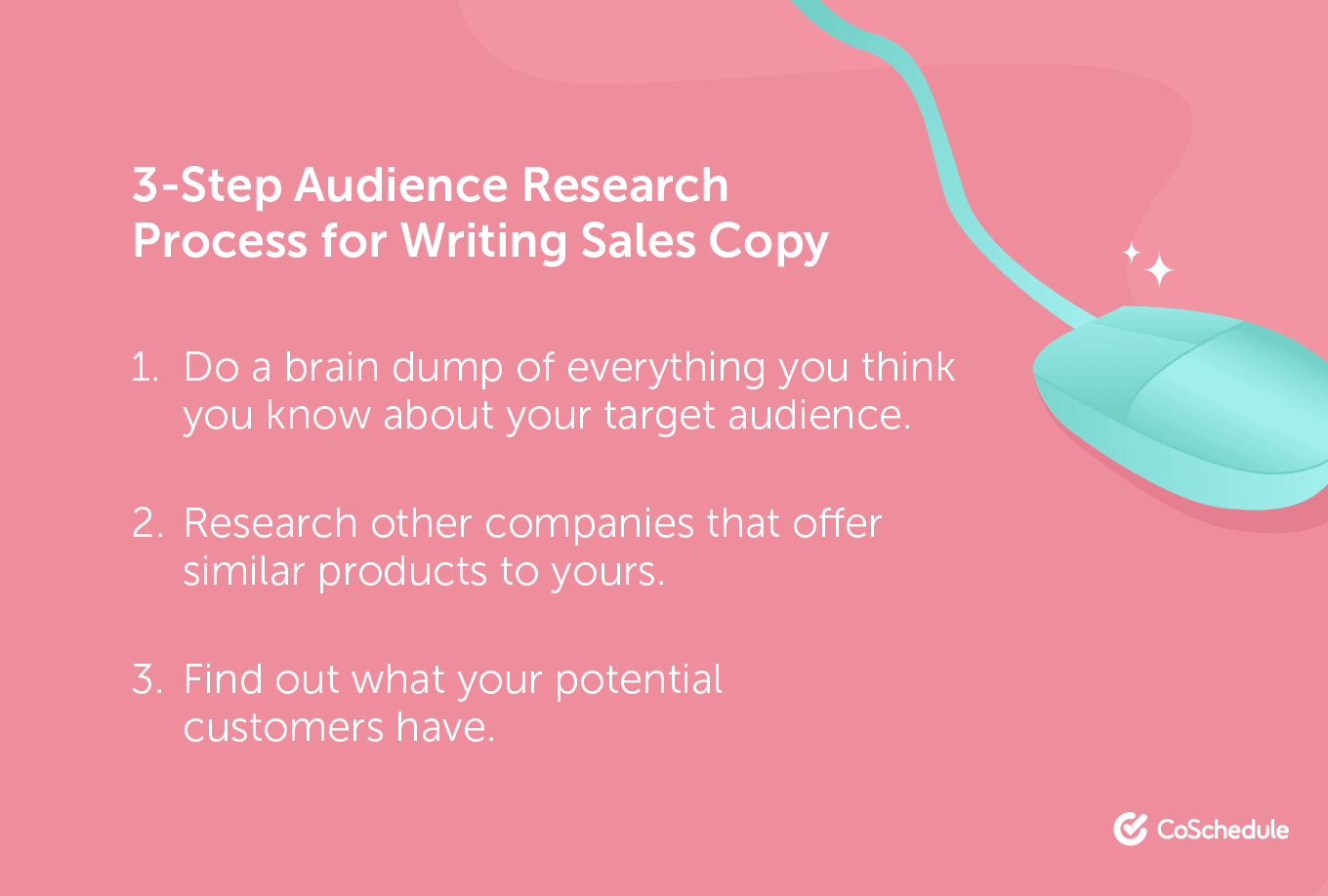 This research will help you draw up a list of problems your audience is facing. You will be able to show your product solves these issues. Just as importantly, you will understand what your audience wants to achieve through using your product.
You should have multiple examples for each.
Good sales copy involves touching on these different points. If you make the mistake of writing a long-form sales page which fails to address your customers needs and wants they won't buy from you.
This research will help you draw up a list of problems your audience is facing. You will be able to show your product solves these issues. Just as importantly, you will understand what your audience wants to achieve through using your product.
You should have multiple examples for each.
Good sales copy involves touching on these different points. If you make the mistake of writing a long-form sales page which fails to address your customers needs and wants they won't buy from you.
If you make the mistake of writing a long-form sales page which fails to address your customers needs and wants they won't buy from you.
Click To Tweet2. Decide How to Structure Your Digital Sales Page
There are several copywriting formulas writers use to structure their long-form sales pages. One of the most commonly used is the AIDA Formula. AIDA stands for Attention, Interest, Desire, and Action. You will have seen this formula used on several sales pages. For example, AppSumo uses the AIDA formula for their lifetime promotions.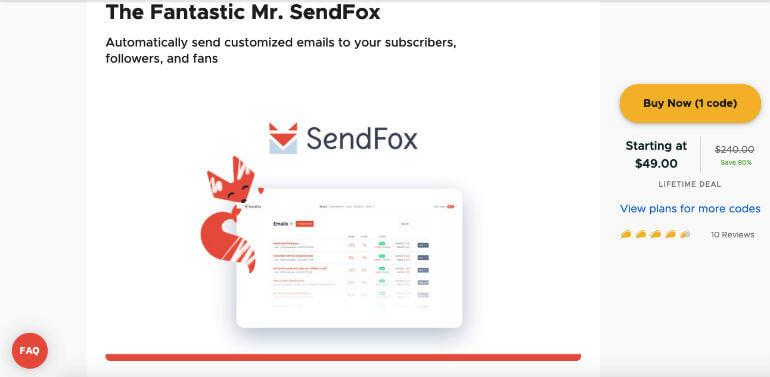 Below is the 15-point checklist AppSumo use for creating a long-form sales page:
Attention
Below is the 15-point checklist AppSumo use for creating a long-form sales page:
Attention
- Headline: illustrates the product benefits
- Sub-headline: more information about the benefit
- Problem: why you need the solution offered
- Video: engage a person in another format/ increase credibility
- Pictures: how to use the product
- Internal Validation: results from power users
- Examples: how to use the product
- Original Price: the saving and benefit of buying it now
- Your Price: First Call to Action (CTA) and buy button
- Testimonials: feedback from relatable customers
- Objections: problem followed by the solution
- Benefits: everything the customer is about to receive
- Offer: final CTA and buy button
- Scarcity: how long until the offer expires
- Social Proof: reviews and Q&A in the comments
 My friend gave me this formula a few years ago. Again, it works.
My friend gave me this formula a few years ago. Again, it works.
“If you’re starting on your journey as a copywriter, follow strategies used by copywriting experts. The strategies they use are based on years of experience.”Bertrand, founder of Youzign This brings us nicely onto the final step of the copywriting formula. In this section, I’ll review how to write long-form sales pages, that looks more like a blog post, or an email than a sales page. They are effective. You will see elements of them incorporated within the kind of sales pages that I described above.
3. Genre: Decide On Your Approach
It’s a fact of life that most of us mimic our peers. One person comes up with a great idea and other people quickly *steal* imitate. It’s a part of life. With copywriting, there are certain writing styles you’ll see used time and again. You could call these approaches copywriting genres. With long-form style sales letters and editorial sales pages, these genres are well established. Each genre has a particular kind of headline and narrative. If you want to create a long-form sales page, you should learn about these styles, because they are used all the time in sales copy. Below are six common copywriting genres you’ll frequently encounter, along with an example sales page that uses the formula.Here are six common copywriting genres you’ll frequently encounter, along with an example sales page that uses the formula.
Click To TweetThe Personal Letter
This is a direct message to your audience. You position yourself as a friend (FYI, this is what AppSumo do in their sales emails). The letter from a niche influencer is another popular approach that falls into this genre. One of the best examples of a copywriter who uses this approach to generate sales is Frank Kern. He’s been using the personal letter formula to connect with his audience for years. Here is an example from 2013.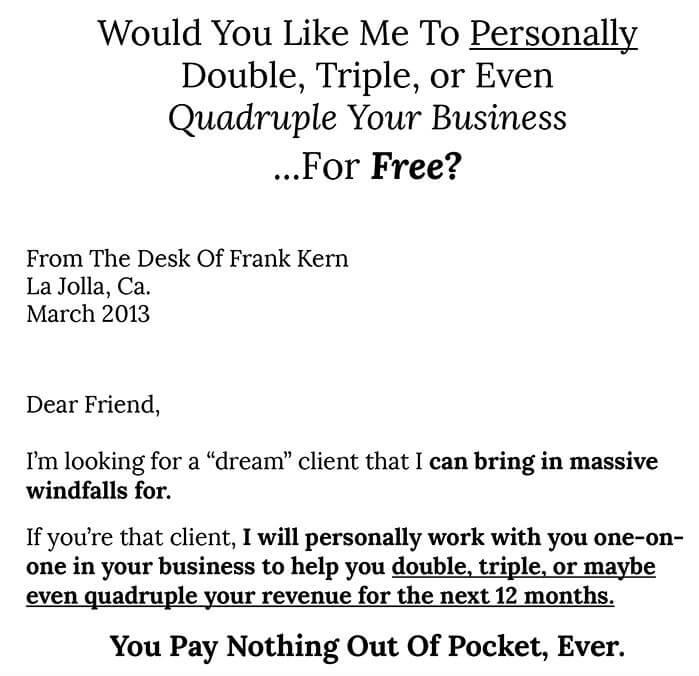 Source: Swiped
I know what you’re thinking; it doesn’t look very sexy. Below is a variant of the open letter he is using to sell his recently released online marketing book.
Source: Swiped
I know what you’re thinking; it doesn’t look very sexy. Below is a variant of the open letter he is using to sell his recently released online marketing book.
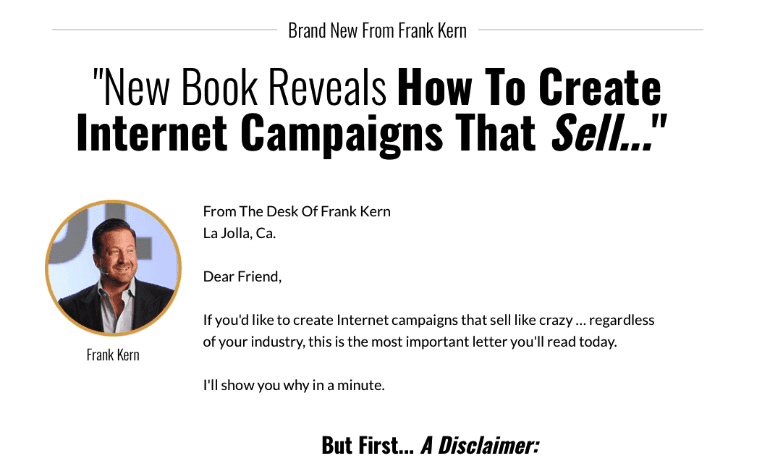 You can check out the book and the ad copy here.
A personal letter works well when you have a clear idea in your mind of the audience you are writing to and their pain points.
You can check out the book and the ad copy here.
A personal letter works well when you have a clear idea in your mind of the audience you are writing to and their pain points.
A personal letter works well when you have a clear idea in your mind of the audience you are writing to and their pain points.
Click To TweetI Tried Everything
The world is against the customer. They work hard. The only reason they haven’t succeeded is that they didn’t have the right approach. Luckily you’re there to help… Well, this is the premise for the I Tried Everything sales page. This message will resonate with a vast market across a variety of niches. For example:- Internet marketing & SEO
- Dieting
- Exercise and fitness
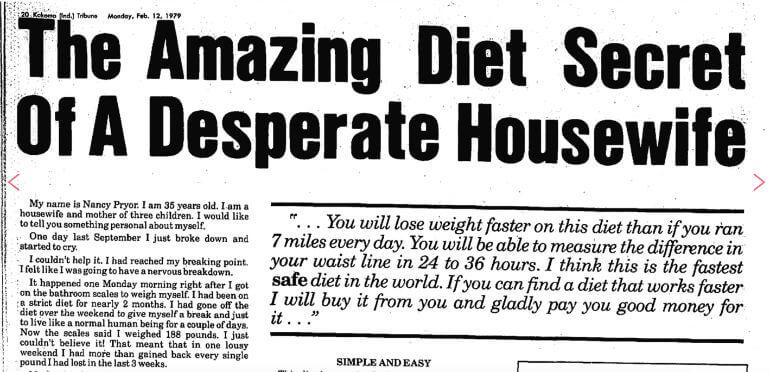 Source: Swiped
This piece of sales copy was published in 1979, and written by Mike Schauer. The same style of copy targeting the same niche will no doubt generate sales if you publish it tomorrow, or 25 years from now.
Source: Swiped
This piece of sales copy was published in 1979, and written by Mike Schauer. The same style of copy targeting the same niche will no doubt generate sales if you publish it tomorrow, or 25 years from now.
The Open Letter
The open letter presents the author as an objective and trustworthy voice. Think friendly college professor who relies on facts, and stats to make the case. One of the most famous examples of the open letter was by Louis Mengel of Merrill Lynch. The open letter is 6,540 words long. It was published on October 19, 1948, in the New York Times. The ad was run in various forms from 1948-1965.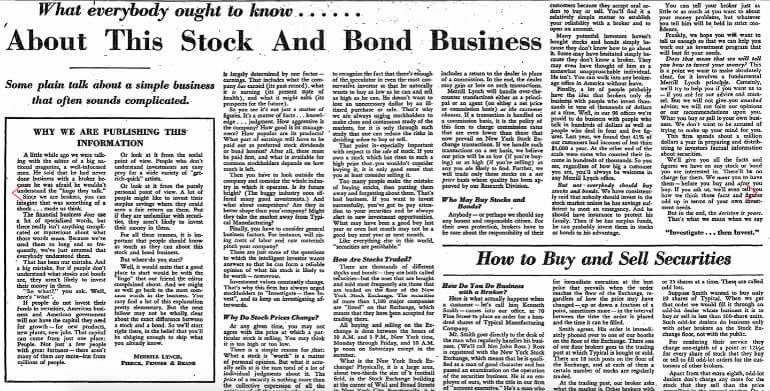 Source: Swiped
You can see that it starts with a box with the headline “Why We Are Publishing this Information.” This box of text nicely outlines why you should care.
The open letter is a format that is very effective for timely news stories. It can look more like a blog post than a sales page, but written well it is just as effective.
Source: Swiped
You can see that it starts with a box with the headline “Why We Are Publishing this Information.” This box of text nicely outlines why you should care.
The open letter is a format that is very effective for timely news stories. It can look more like a blog post than a sales page, but written well it is just as effective.
The open letter is a format that is very effective for timely news stories.
Click To TweetThe Reluctant Hero
The Reluctant Hero is the most commonly used sales page formula. The plot for these sales pages follows one that you would be familiar with from a Disney style fairytale. It goes a bit like this; Once upon a time in a land far away…- A person is forced to develop a solution to a problem he or she encounters/ they have a natural talent
- He or she becomes an expert in their field
- Friends and business acquaintances start asking for help
- The pupils start to get similar amazing results
- Now you, the customer, have the opportunity to purchase the product or access the course
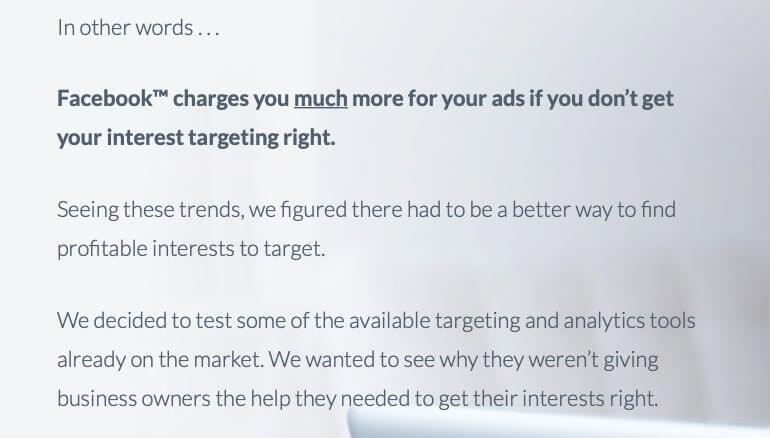 Here is an example of the Reluctant Hero at work on a piece of sales copy for ConnectExplore. You can see how the team behind the software identified a problem they felt obligated to solve.
Here is an example of the Reluctant Hero at work on a piece of sales copy for ConnectExplore. You can see how the team behind the software identified a problem they felt obligated to solve.
The Special Report
The Special Report is a sales technique that leverages authority and credibility. It usually takes the form of an article that shares a unique insight into a niche. There are particular niches where this formula is effective. For example, banking. A headline like, “500% Increase in 2019: A Special Report On The Alternative Meat Market” by JPMorgan Chase, would be an undeniable page-turner for anyone interested in investing in stocks. There are a couple of characteristics of a special report:- The special report addresses something that has just occurred
- It covers a concern your audience have or something they are interested in
- You use data and statistics to justify the points that are made
- It is written, or ghostwritten, by an authority on the topic
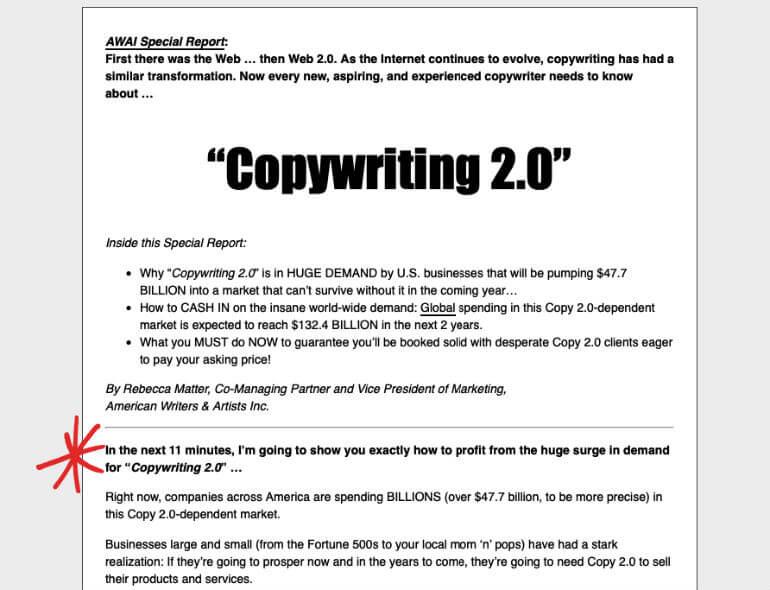 You can find an example of a special report on copywriting by American Writers & Artists Inc. above. It’s a sales page for a $497 information product.
You can find an example of a special report on copywriting by American Writers & Artists Inc. above. It’s a sales page for a $497 information product.
You’re In Our Tribe
People naturally gravitate into tribes. It’s a well-known phenomenon that impacts everything from politics through to advertising. This is a human characteristic that copywriters leverage. One of the longest running examples of a You’re In Our Tribe sales is the “Tale of Two Young Men.” This was written by Martin Conroy. The sales letter is responsible for selling $2 billion worth of Wall Street Journal subscriptions.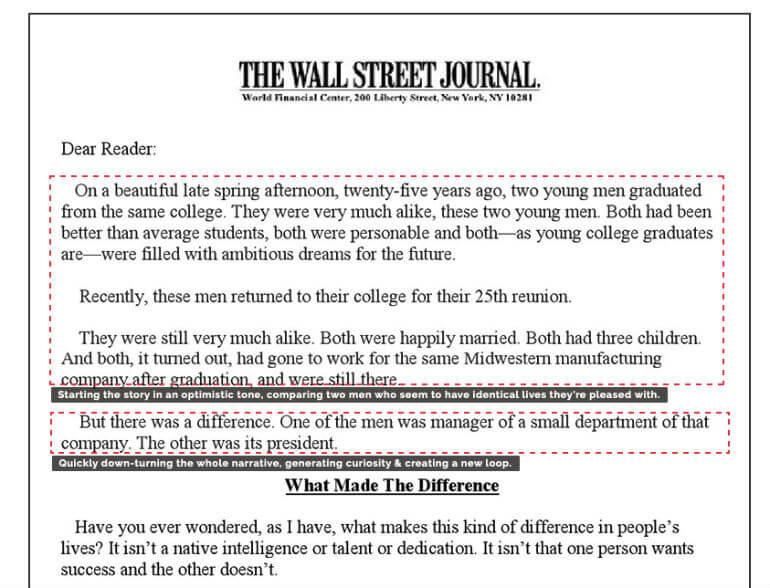 Source: Swiped
The sales letter tells the story of two people with the same opportunities in life. However, thanks to reading the Wall Street Journal, one was very successful. The other was a middle-ranking manager.
This copywriting formula works well for an info-course. This is how the Wall Street Journal was positioned in the famous ad.
Source: Swiped
The sales letter tells the story of two people with the same opportunities in life. However, thanks to reading the Wall Street Journal, one was very successful. The other was a middle-ranking manager.
This copywriting formula works well for an info-course. This is how the Wall Street Journal was positioned in the famous ad.
Your 5-Point Sales Page Checklist
In this final section, we’ll cover five essential ingredients of a long-form sales page. These hacks cover points you need to be aware of if you want to write effective copy.1. Create a Compelling Headline
The fact that a headline is important is just common sense. Your headline is the first thing a person sees when they land on your sales page. A good headline draws a reader in. You need to get this right if you want to make a sale. When it comes to a sales page, your headline is even more critical. Ideally, your headline should do the following:- Focus on the most significant pain point your customer has
- Offer a clear value proposition
- Quickly reflect what the reader can expect from the rest of the page
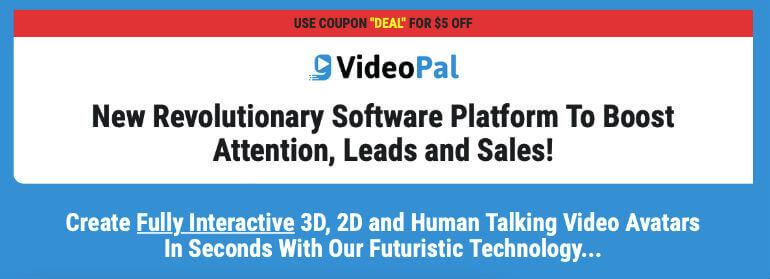 The headline sets the expectation. The sub-headline then expands upon the promise.
Don’t be afraid to play around with the visuals to emphasize words. For example, on this sales page for OctoSuite, they underlined text, use bold, and different colors. It might look messy, but it’s effective.
The headline sets the expectation. The sub-headline then expands upon the promise.
Don’t be afraid to play around with the visuals to emphasize words. For example, on this sales page for OctoSuite, they underlined text, use bold, and different colors. It might look messy, but it’s effective.
 It’s easy to write a list of desirable traits for a headline. It’s a lot harder to write an engaging headline and sub-headline.
The simplest way I’ve found to do this is to borrow a formula that works. You can then adapt the headline to fit your needs. Alternatively, there are plenty of headline generators that will help you come up with an idea.
It’s easy to write a list of desirable traits for a headline. It’s a lot harder to write an engaging headline and sub-headline.
The simplest way I’ve found to do this is to borrow a formula that works. You can then adapt the headline to fit your needs. Alternatively, there are plenty of headline generators that will help you come up with an idea.
2.How to Use Crosshead in Your Copy
One of the things that distinguishes a long-form sales page is the amount of copy on the page. As I showed you earlier, a long-form sales page can have thousands of words of copy. At some point as you scroll down a page which is just a chunk of text, your eyes will glaze over. The copywriting solution to this issue is known as crossheads. Crossheads are headlines that run across the page. They break up the content. Crossheads are used every 3-4 paragraphs in a piece of sales copy, or on a sales page. They draw the eye of the reader and make them engage with the copy. The other characteristic of a crosshead is they often tell a story. To illustrate my point I’ll show you an example from a sales page. The offer, now expired, is for a white label product created for affiliate marketers.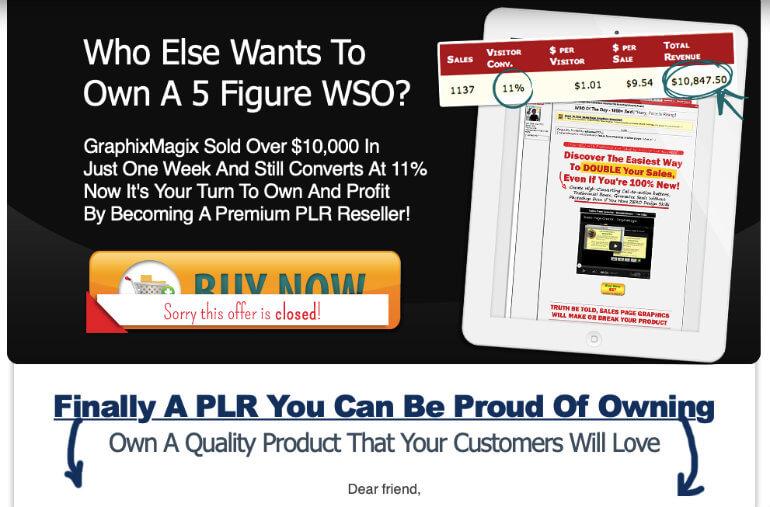 Below are the crossheads used on the page:
Below are the crossheads used on the page:
- Finally a PLR you can be proud of owning
- Start reselling a proven winner
- Become one of 50 PLR rights owner
- Your own professional sales page
- And instant access for your buyers
- Here is what you get
Crossheads are like chapters in a book. You don’t need to read every word of the copy to understand what is being discussed.
Click To Tweet3. Summarize the Benefits Of Your Offer
It can help to think of a long-form sales page as a funnel. At the top part of the funnel, you deal with objections, and create desire. As you get closer to the buy buttons, you need to focus the mind of your reader. You do this by summarizing the benefits of your offer. There are a couple of different methods for doing this. One strategy is the Johnson Box. This is named after the copywriter Frank H. Johnson. It’s essentially a box in a border that sums up your offer. You can see a variation of this used on Consulting.com.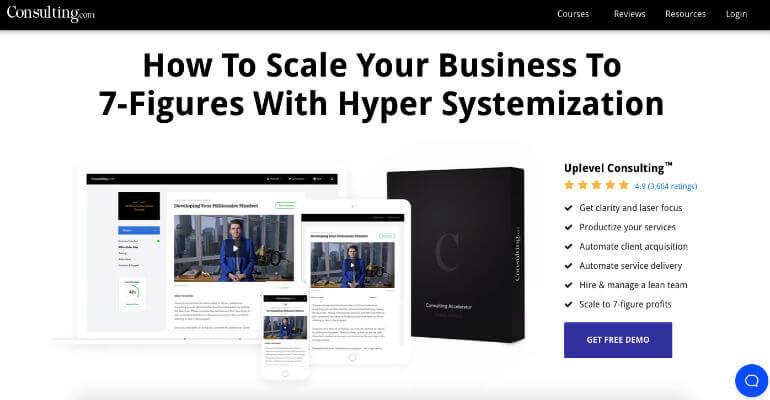 Later down the page, you’ll often find copywriters using an expanded checklist to summarize the offer. You’ll have a small headline with an accompanying description.
Here’s a pretty standard example.
Later down the page, you’ll often find copywriters using an expanded checklist to summarize the offer. You’ll have a small headline with an accompanying description.
Here’s a pretty standard example.
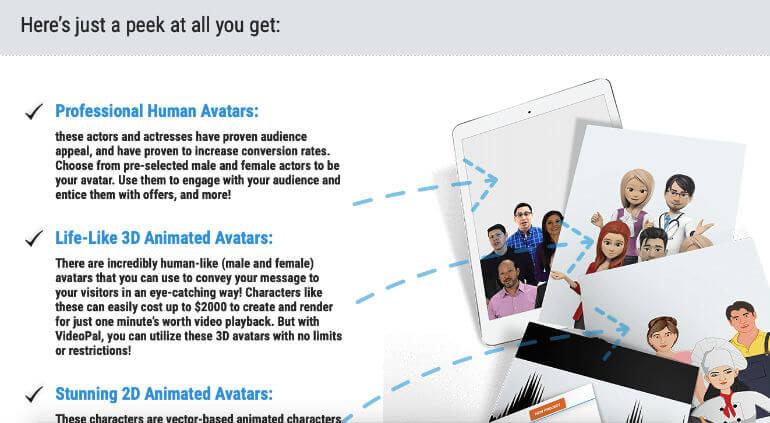 These feature and product summaries will invariably appear before the buy button.
These feature and product summaries will invariably appear before the buy button.
4. Convert a Customer With a Suitable Bonus
People love free things. Especially people who are on the edge of buying something, but don't know if they should do it at that moment. A limited-time bonus is a standard marketing strategy for increasing conversions. They are particularly useful if you are running a special offer. It puts customers into a "now or never" mindset. Common bonuses include:- access to an online course
- an information product like an eBook
- Coaching call
- Access to a private community
- Access to software
- Templates or transcripts
5. Include an FAQ Section
An FAQ section at the end of your sales page is a logical way to wrap up your sales copy. The FAQ section is a chance for you to address the obstacles that your customer has directly. In many ways, it serves the same purpose as the summary of benefits:- Summarizes the pain points a customer may have
- Condenses the points you addressed in the copy
- Address issues that you didn't have the opportunity to include in your sale copy


